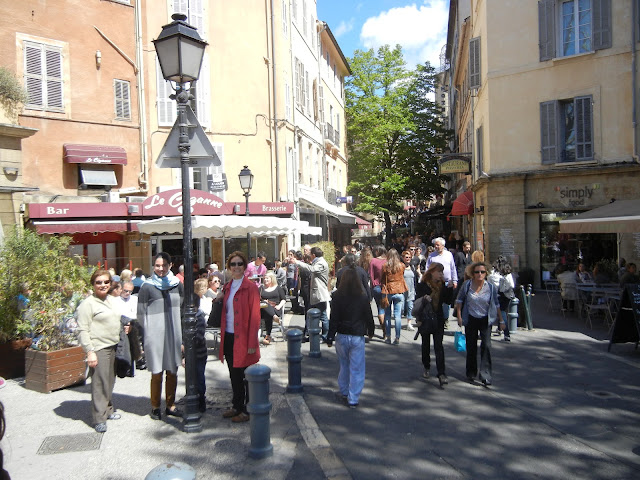Our first stop was in Aix-en-Provence, a small city that during the Middle Ages was the capital of Provence. We headed straight for the Cours Mirabeau, the wide and beautiful main avenue in the old part of Aix planted with double rows of Plane trees and decorated by four fountains, two in the middle and one at each end. At one end is La Rotonde, at the Place du General de Gaulle, with its beautiful round fountain; at the other end is Place Forbin, with its small fountain and statue of King René I of Anjou. We stopped for some refreshments and to enjoy the sunny morning at a quaint café facing Place du General de Gaulle.
From Aix-en-Provence it’s a short drive to Marseille, and we
got there in time for lunch at the old port. Marseille is France's largest city on the Mediterranean and largest commercial port. It is famous for the Bouillabaisse, a traditional Provençal fish stew, but we didn't like that the fish is served separately from the soup. The mussels, however, were excellent.
Marseille, or rather, its inhabitants, are famous for giving France its national anthem. The song, originally titled "Chant de guerre pour l'armée du Rhin," was composed at Strasbourg by Claude Joseph Rouget de Lisle in 1792 in a moment of patriotic furor during the invasion of France by Prussia and Austria, intending to end the Revolution and restore the traditional monarchy. Volunteers from Marseille sent to Paris to defend the revolutionary government used it as their marching song. La Marseillaise, as it became known, was adopted by the French National Convention as the Republic's anthem in 1795.
After visiting the old port we went up the hill to see the magnificent basilica of Notre Dame de la Garde, situated at the highest point in Marseille, a major local landmark and the symbol of Marseille. Local inhabitants commonly refer to it as la bonne mère ("the good mother") and regard it as the guardian of the port city.
After visiting the old port we went up the hill to see the magnificent basilica of Notre Dame de la Garde, situated at the highest point in Marseille, a major local landmark and the symbol of Marseille. Local inhabitants commonly refer to it as la bonne mère ("the good mother") and regard it as the guardian of the port city.

The bell tower, which supports a tall statue of the Madonna
and Child made out of copper gilded with gold leaf, can be seen from everywhere. Inside of the church, the ceilings, the wall mosaics, and the red and
white marble pillars and columns are magnificent.
From up there the views of Marseille and the ocean are breathtaking. Down below is the old port and the 17th century Fort Saint-Jean, a fortification built in
1660 by Louis XIV at the entrance to the old port. Two earlier buildings were
incorporated into the structure of the fort: the 12th century Commandry of the
Knights Hospitaller of St John, which served as a monastic hospice during the
crusades, and the 15th century tower of René I.















